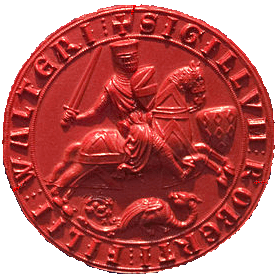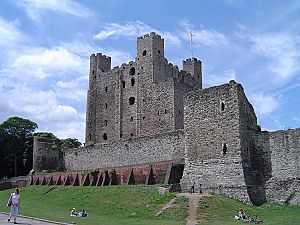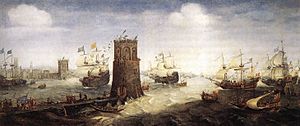Robert Fitzwalter facts for kids
Quick facts for kids
Robert Fitzwalter
|
|
|---|---|

Seal of Robert Fitzwalter. It shows a knight on a horse, holding a sword. His family's coat of arms is on his shield and the horse's blanket.
|
|
| Reign | 1198–1235 |
| Predecessor | Walter Fitz Robert |
| Successor | Sir Walter Fitzwalter |
| Died | 9 December 1235 Little Dunmow, Essex, England |
| Buried | Priory Church, Little Dunmow |
| Noble family | Fitzwalter |
| Spouse(s) |
|
| Issue |
|
| Father | Walter Fitz Robert |
| Mother | Maud de Lucy |
Robert Fitzwalter (died 9 December 1235) was an important English noble. He was one of the main leaders who stood against King John. He also helped create the Magna Carta, a famous document that limited the king's power. Robert Fitzwalter was one of the twenty-five nobles chosen to make sure the king followed the Magna Carta.
He was the feudal baron of Little Dunmow, in Essex. He was also in charge of Baynard's Castle in London. This job meant he was the chief knight of the City of London. Robert Fitzwalter fought for King John in wars in Normandy. During these wars, he was captured by King Philip II of France and had to pay a large sum of money to be freed.
Contents
Early Life and Family Connections

Robert Fitzwalter was the son of Walter Fitz Robert and Maud de Lucy. His family had been important in England since the Norman conquest. They were known for helping to run the country. Robert's family owned land in Dunmow and a special area in London called the soke of Baynard's Castle. This made them very close to the people of London. Robert himself was involved in trade and owned ships that carried wine.
We don't know much about Robert Fitzwalter's early life. He married Gunnor de Valognes before his father died in 1198. Gunnor was an heiress, meaning she inherited a lot of land. Robert had three children: Matilda, Robert, and Christina. His eldest son, Robert, died before him. His other son, Walter, became his heir. After Gunnor died, Robert married a second wife named Rohese.
Robert's Career and Influence
When Robert's father died in 1198, Robert took over his family's lands. His marriage to Gunnor brought him even more land. He also gained land from his uncle, Godfrey de Luci. Because of all his land and connections, Robert Fitzwalter became one of the most powerful men in England. His lands were mostly in the north, which connected him to a group of northern nobles. He later led this group against King John.
Robert was involved in several legal cases. In 1202, King John made Robert the warden of Hertford Castle. He also helped Robert with his family's debts. In 1203, Robert was with King John in Normandy. He was put in charge of the castle of Le Vaudreuil with his cousin, Saer de Quincy, 1st Earl of Winchester. However, they surrendered the castle to King Philip II of France very quickly. They were held prisoner until a large ransom was paid. The reason for their quick surrender is still a mystery.
The 1212 Conspiracy
King John's poor rule made many nobles, including Robert Fitzwalter, very angry. In 1212, Robert and other nobles began to plot against the king. Some stories say that King John had wronged Robert personally. However, it seems more likely that the nobles were unhappy because King John was taking too much money from them.
In 1212, King John was having serious problems with the Pope and the King of France. The Pope even told the English nobles they no longer had to obey John. King John suspected his nobles were plotting against him. Robert Fitzwalter and another noble, Eustace de Vesci, fled England. King John then took Robert's lands and destroyed his castles, including Baynard's Castle. Robert stayed in exile until King John made peace with the Pope. After this, Robert's lands were given back to him.
The Magna Carta Revolt
Robert Fitzwalter continued to strongly oppose King John. In 1214, Robert and other nobles met in secret. They decided to fight King John if he did not agree to their demands for a new charter by Christmas. Both sides began to prepare for war.
In 1215, Robert Fitzwalter was one of the first nobles to gather against the king. When King John refused their demands, the nobles chose Robert Fitzwalter as their general. They gave him the title "Marshal of the Army of God and Holy Church". The nobles then officially stopped obeying King John. They tried to capture Northampton and Bedford, but failed.
However, London supported them, which helped them greatly. Robert Fitzwalter's influence in London was key. On May 17, Robert entered London with the "army of God." He and the Earl of Essex worked to fix London's walls. They even used stones from houses that had been torn down.
In June, King John met the nobles at Runnymede. There, they agreed to the Magna Carta. This document included a rule that no one could be sent away from the country without a fair trial. This rule was especially important for Robert Fitzwalter. Robert was one of the twenty-five nobles chosen to make sure the Magna Carta was followed. For a short time, there was peace. Robert even got back control of Hertford Castle.
The First Barons' War

Peace did not last long. In August, the First Barons' War began. Robert Fitzwalter and Eustace de Vesci were still the main leaders. Robert was put in charge of securing Northamptonshire for their side. Robert also secretly took control of Rochester Castle to protect it from the king. However, King John's troops soon attacked. Robert was forced to retreat to London, and Rochester Castle was captured.
On December 16, Robert and other nobles were officially excommunicated by the Pope. This meant they were cut off from the Church. Their only hope was to get help from France. Robert went to France with other nobles and offered the English throne to Prince Louis, the son of the French king.
Robert returned to England in early 1216. He helped Prince Louis gain control of Essex and Suffolk. After King John died in October, it became harder for Robert and his allies. Many English nobles began to support the new young king, Henry III.
On May 20, Robert fought in the Second Battle of Lincoln. The nobles' forces were completely defeated. Robert Fitzwalter and his son were captured. The war finally ended with the 1217 Treaty of Lambeth. Even though Robert was captured, the Magna Carta was reissued. This showed that his cause had won, even if he had lost the battle. Robert was released from prison and his lands were restored.
Later Life and Legacy
In 1219, Robert Fitzwalter went on the Fifth Crusade to the Holy Land. He sailed from Genoa and arrived in Acre. He then joined the siege of Damietta in Egypt. The city was captured by the crusaders in November. Robert later returned home due to illness.
He spent the rest of his life peacefully in England. He was fully reconciled with King Henry III's government. Robert Fitzwalter died on December 9, 1235. He was buried in Priory Church in Little Dunmow. He was remembered as a "noble baron" and famous for his military actions.

Over time, many legends grew around Robert Fitzwalter. He became known as a champion of English freedom. One famous story tells of his beautiful daughter, Matilda. The legend says that King John was interested in Matilda, but she refused him. Because of this, King John caused her to die. This personal tragedy supposedly made Robert Fitzwalter a leader against the king.
This story was so widely believed that a statue in Priory Church, Little Dunmow, is still sometimes said to be Matilda. Several poems and plays have been written about this romantic tale. In these stories, Matilda is often linked to Maid Marian, the love interest of Robin Hood. For example, plays like The Downfall of Robert, Earl of Huntingdon and The Death of Robin Hood feature her. The poet Michael Drayton also wrote about Matilda. Robert Fitzwalter and King John are also central characters in the comic story Magna Charter by Marriott Edgar.




